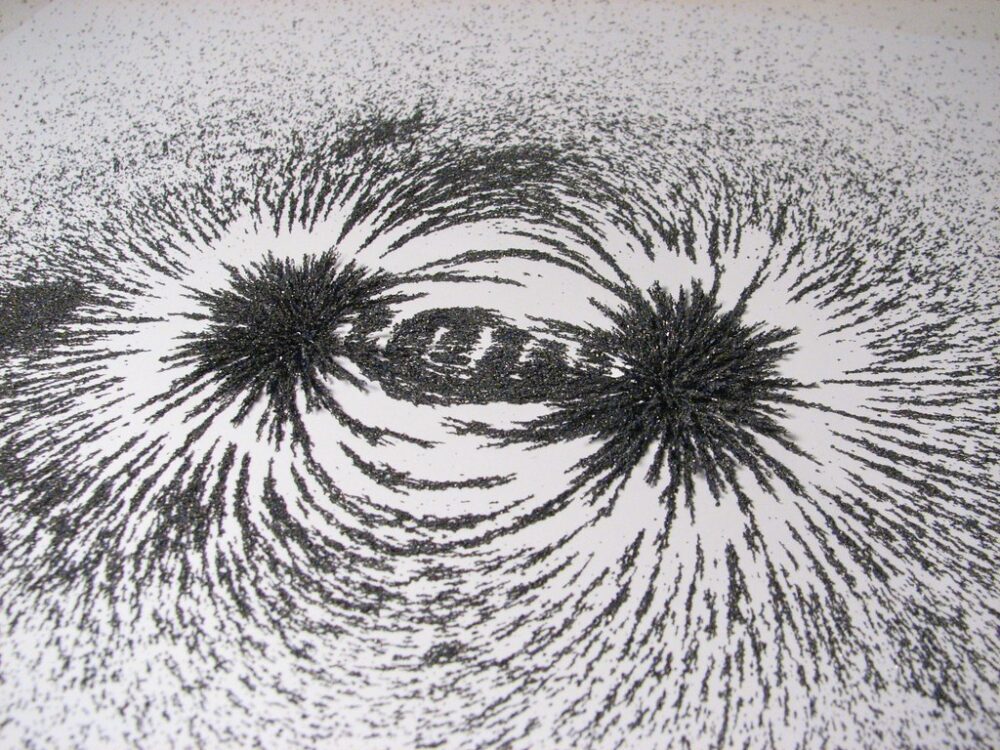At the end of the 19th century, James Clerk Maxwell condensed centuries of work in the study of electricity and magnetism into four eloquent and simple equations. Maxwell’s equations describe electric and magnetic fields as a yin and yang, ebbing and flowing through space. A change in one field creates a swirl in the other, and if they oscillate in sync with one another, they dance together, shooting off into space as electromagnetic radiation: light.
But there was a blemish in the equations: electricity and magnetism weren’t perfectly balanced. Where one equation describes electric charge, the magnetic counterpart just shows zero.
Maxwell’s equations describe electric and magnetic fields as a yin and yang, ebbing and flowing through space.
The most fundamental unit of electric field is electric charge, which can exist at one point that creates a monopole in the electric field. However, the most fundamental unit of magnetic field mimics two charges, a negative and a positive, perfectly canceling out to create a dipole shape and a total magnetic charge of zero, just as Maxwell’s equations describe.
When Maxwell published his four equations, physicists had questions. Why weren’t the equations symmetric? What explained the added complexity to the equations? These questions are motivated by the philosophical principle of Occam’s razor: When two hypotheses make the same prediction, the one with the fewest assumptions, the simplest explanation, is the stronger theory. In physics, simpler math means fewer assumptions are made about the fundamental nature of the Universe.
In physics, simpler math means fewer assumptions are made about the fundamental nature of the Universe.
This search for simplicity is behind theories of everything, looking to unify all four of the most fundamental forces into one, and the concept of supersymmetry in particle physics, which asserts that each particle has a symmetric counterpart.
Maxwell’s theory didn’t prohibit magnetic monopoles from existing; he just didn’t include them in his equations because no one had ever observed magnetic charge. In the extension of Maxwell’s electrodynamics to quantum theory, physicists introduced mathematical gauges, or hidden underlying mathematical machinery that helped simplify the math of theories without holding any physical significance.
These gauges polarized physicists because they tended to imply magnetic monopoles didn’t exist — in part simply because Maxwell’s equations, from which their theories were derived, didn’t include them. Some physicists accepted the conclusions of these gauges, which were supported by experimental results. Others worked to include magnetic monopoles into more complex quantum gauges, leaving the possibility for their existence open. By the 1970s, it seemed quantum mechanics had killed the idea of magnetic charge.
Then, as physicists began developing the math for theories to unify the four fundamental forces, the gauges used in the math seemed to imply — and rely on — magnetic monopoles existing. For many of these theories, this prediction from the pure math spelled trouble: The types of monopoles it predicted were over a quadrillion times heavier than protons and just as plentiful. This, of course, would have collapsed the Universe billions of years ago, so physicists added a mechanism that would cause these monopoles to be extremely rare and almost undetectable.
All these theories — from the original conception of magnetic monopoles to the attempts to unify the fundamental forces — which were inspired by Occam’s razor, now seemed to violate it. By trying to find the simplest possible math to describe the Universe, they required counterintuitive, massive, exotic particles to exist and complementary theories to explain why we can’t find them.
The goal of physics is to explain “how” the universe works, not “why” it is what it is. Occam’s razor is not infallible, but physicists use it for guidance because it implies testability: a theory is only relevant to science if experimentalists can test it against real-world observations, and simpler theories tend to be easier to test. Scientists can almost always add complexity to theories to explain why certain predictions can’t be observed.
This fact is uncomfortable because the question “why does the universe have complexity?” really boils down to “why are we here?” — but our complex existence ultimately requires a fundamentally complex universe.
A universe with symmetric electric and magnetic charges and completely interchangeable fields sounds elegant and beautiful, but it is not the universe we live in. Evidence does not favor the explanations that our universe’s forces must combine into one force, that all particles have perfectly symmetric counterparts, or that electricity and magnetism are equal.
This fact is uncomfortable because the question “why does the universe have complexity?” really boils down to “why are we here?” — but our complex existence ultimately requires a fundamentally complex universe.
Playing with these abstract theories can provide insight into what’s next for the field of physics, but we shouldn’t stray too far down the symmetry path without experimental support. At some point, we have to embrace the asymmetry and complexity that brought us here.

Contemporary Physics (2012). DOI: 10.1080/00107514.2012.685693



